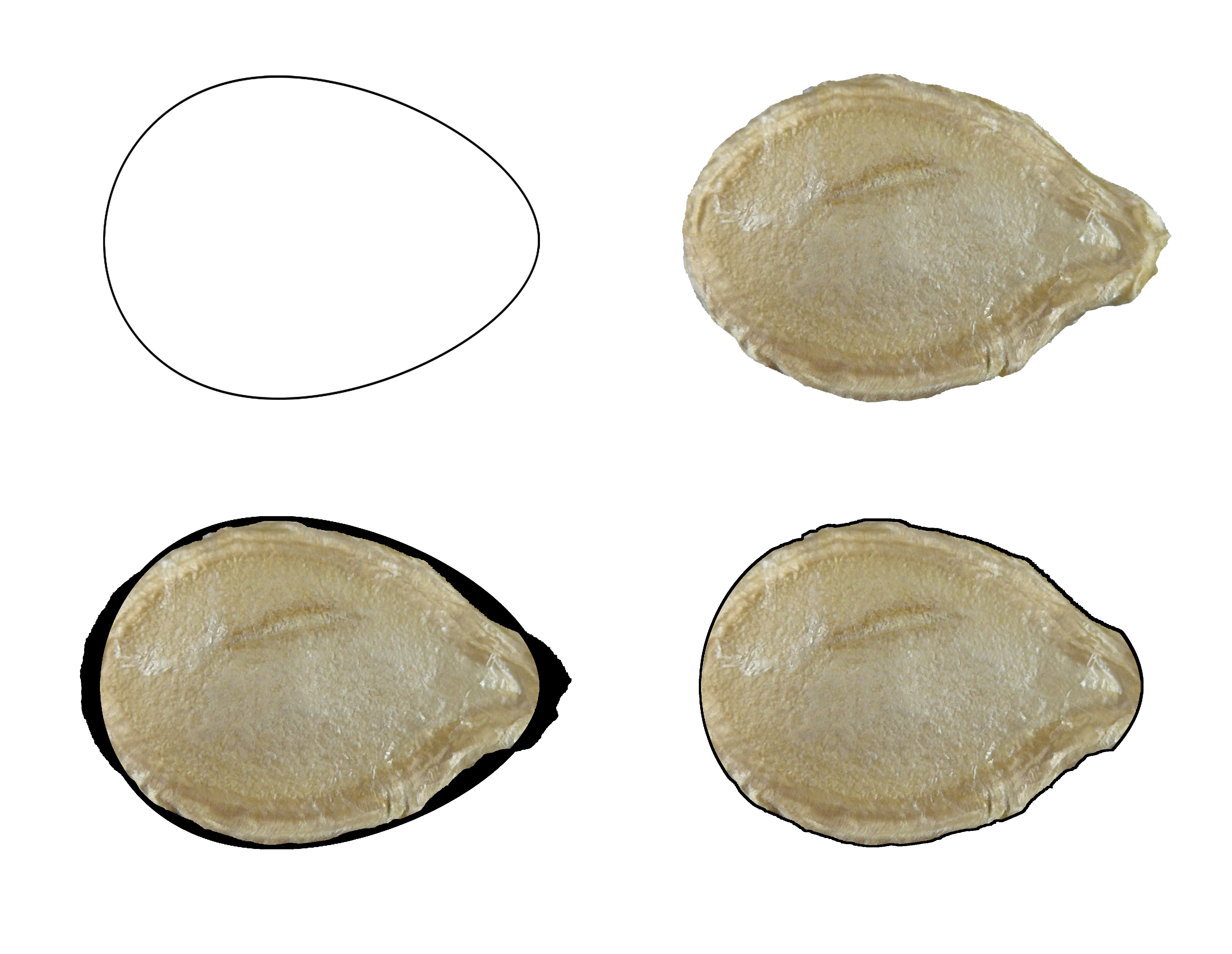Seed shape quantification in the order Cucurbitales
Abstract
Seed shape quantification in diverse species of the families belonging to the order Cucurbitales is done based on the comparison of seed images with geometric figures. Quantification of seed shape is a useful tool in plant description for phenotypic characterization and taxonomic analysis. J index gives the percent of similarity of the image of a seed with a geometric figure and it is useful in taxonomy for the study of relationships between plant groups. Geometric figures used as models in the Cucurbitales are the ovoid, two ellipses with different x/y ratios and the outline of the Fibonacci spiral. The images of seeds have been compared with these figures and values of J index obtained. The results obtained for 29 species in the family Cucurbitaceae support a relationship between seed shape and species ecology. Simple seed shape, with images resembling simple geometric figures like the ovoid, ellipse or the Fibonacci spiral, may be a feature in the basal clades of taxonomic groups.
References
APG 2009. An update of the Angiosperm Phylogeny Group classification for the orders and families of flowering plants: APG III. Bot. J. Linn. Soc. 161: 105–121. https://doi.org/10.1111/j.1095-8339.2009.00996.x
APG 2016. An update of the Angiosperm Phylogeny Group classification for the orders and families of flowering plants: APG IV. Bot. J. Linn. Soc. 181: 1–20. https://doi.org/10.1111/boj.12385
Begon M., Harper J.L., Townsend C.R. 2005. Ecology: From individuals to ecosystems. Wiley-Blackwell, Oxford, UK.
Cervantes E., Martín J.J., Chan P.K., Gresshoff P.M., Tocino Á. 2012. Seed shape in model legumes: Approximation by a cardioid reveals differences in ethylene insensitive mutants of Lotus japonicus and Medicago truncatula. J. Plant Physiol. 169 (14): 1359–1365. https://doi.org/10.1016/j.jplph.2012.05.019
Cervantes E., Martín J.J., Saadaoui E. 2016. Updated methods for seed shape analysis. Scientifica (Cairo): 5691825. https://doi.org/10.1155/2016/5691825
Cervantes E., Martín J.J., Ardanuy R., de Diego J.G., Tocino Á. 2010. Modeling the Arabidopsis seed shape by a cardioid: Efficacy of the adjustment with a scale change with factor equal to the Golden Ratio and analysis of seed shape in ethylene mutants. J. Plant Physiol. 167 (5): 408–410. https://doi.org/10.1016/j.jplph.2009.09.013
Christenhusz M.J.M., Byng J.W. 2016. The number of known plants species in the world and its annual increase. Phytotaxa 261 (3): 201–217. http://dx.doi.org/10.11646/phytotaxa.261.3.1
de Wilde J.J.F.E. 2011. Begoniaceae Bercht. & J. Presl (1820), nom. cons. In: Kubitzki K. (ed.), Flowering Plants. Eudicots: Sapindales, Cucurbitales, Myrtaceae: 56–71. Springer.
Grillo O., Draper D., Venora G., Martínez-Laborde J.B. 2012. Seed image analysis and taxonomy of Diplotaxis DC. (Brassicaceae, Brassiceae). Syst. Biodiv. 10 (1): 57–70. https://doi.org/10.1080/14772000.2012.658881
Heneidak S., Abdel Khalik K. 2015. Seed coat diversity in some tribes of Cucurbitaceae: Implications for taxonomy and species identification. Acta Bot. Bras. 29 (1): 129–142. https://dx.doi.org/10.1590/0102-33062014abb3705
Kubitzki K. 2011a. Coriariaceae DC. (1824), nom. cons. In: Kubitzki K. (ed.), Flowering Plants. Eudicots: Sapindales, Cucurbitales, Myrtaceae: 105–108. Springer.
Kubitzki K. 2011b. Introduction to Cucurbitales. In: Kubitzki K. (ed.), Flowering Plants. Eudicots: Sapindales, Cucurbitales, Myrtaceae: 4–6. Springer.
Kubitzki K. 2011c. Corynocarpaceae Engler (1897), nom. cons. In: Kubitzki K. (ed.), Flowering Plants. Eudicots: Sapindales, Cucurbitales, Myrtaceae: 109–111. Springer.
Martín J.J., Saadaoui E., Cervantes E. 2016. Seed shape of castor bean (Ricinus communis L.) grown in different regions of Tunisia. J. Agric. Ecol. Res. Int. 8 (1): 2394–1073. https://dx.doi.org/10.9734/JAERI/2016/23934
Martín J.J., Tocino Á., Ardanuy R., de Diego J.G., Cervantes E. 2014. Dynamic analysis of Arabidopsis seed shape reveals differences in cellulose mutants. Acta Physiol. Plant. 36 (6): 1585–1592. https://doi.org/10.1007/s11738-014-1534-8
Mattana E., Grillo O., Venora G., Bacchetta G. 2008. Germplasm image analysis of Astragalus maritimus and A. verrucosus of Sardinia (subgen. Trimeniaeus, Fabaceae). Anales Jard. Bot. Madrid. 65: 149–155. https://doi.org/10.3989/ajbm.2008.v65.i1.252
Matthews M.I., Endress P.K. 2004. Comparative floral structure and systematics in Cucurbitales (Corynocarpaceae, Coriariaceae, Tetramelaceae, Datiscaceae, Begoniaceae, Cucurbitaceae, Anisophylleaceae). Bot. J. Linn. Soc. 145 (2): 129–185. https://doi.org/10.1111/j.1095-8339.2003.00281.x
Reveal J.L., Chase M.W. 2011. APG III: Bibliographical Information and synonymy of Magnoliidae. Phytotaxa 19: 71–134. http://dx.doi.org/10.11646/phytotaxa.19.1.4
Rovner I., Gyulai F. 2007. Computer-assisted morphometry: A new method for 340 assessing and distinguishing morphological variation in wild and domestic seed 341 populations. Econ. Bot. 61 (2): 154–172.
Saadaoui E., Martín J.J., Bouazizi R., Romdhane C.B., Grira M., Abdelkabir S., Khouja M.L., Cervantes E. 2015. Phenotypic variability and seed yield of Jatropha curcas L. introduced to Tunisia. Acta Bot. Mex. 110: 121–136.
Saadaoui E., Martín J.J., Cervantes E. 2013. Intraspecific variability of seed morphology in Capparis spinosa L. Acta Biol. Cracov. Ser. Bot. 55 (2): 99–106. https://doi.org/10.2478/abcsb-2013-0027
Saadaoui E., Martín J.J., Nizar T., Adelhamid K., Cervantes E. 2017. Effect of climate in seed diversity of wild Tunisian Rhus tripartita (Ucria) Grande. J. Adv. Agric. Biotech. 13 (4): 1–10. https://doi.org/10.9734/JABB/2017/32786
Sahai K., Kaur H., Pal A. 1997. Macro- and micromorphological seed characteristics of some Cassia species and their taxonomic significance. Phytomorphol. 47 (3): 273–279.
Schaefer H., Renner S.S. 2011. Cucurbitaceae Durande (1782), nom. cons. In: Kubitzki K. (ed.), Flowering Plants. Eudicots: Sapindales, Cucurbitales, Myrtaceae: 112–174. Springer.
Sonka M., Hlavac V., Boyle R. 2008. Image processing analysis and machine vision. Thomson.
Swensen S., Kubitzki K. 2011. Datiscaceae Bercht. & J. Presl (1820), nom. cons. Tetramelaceae Airy Shaw (1965). In: Kubitzki K. (ed.), Flowering Plants. Eudicots: Sapindales, Cucurbitales, Myrtaceae: 175–179. Springer.
Thorne R.F., Reveal J.L. 2007. An updated classification of the class Magnoliophyta (‘Angiospermae’). Bot. Rev. 73: 67–181. http://www.jstor.org/stable/4354528
Venora G., Grillo O., Ravalli C., Cremonini R. 2007. Tuscany beans landraces, on-line identification from seeds inspection by image analysis and linear discriminant analysis. Agrochimica 51 (4–5): 254–268.


This work is licensed under a Creative Commons Attribution-NonCommercial-NoDerivatives 4.0 International License.
The journal is licensed by Creative Commons under BY-NC-ND license. You are welcome and free to share (copy and redistribute the material in any medium or format) all the published materials. You may not use the material for commercial purposes. You must give appropriate credit to all published materials.
The journal allow the author(s) to hold the copyrights and to retain publishing rights without any restrictions. This is also indicated at the bottom of each article.





